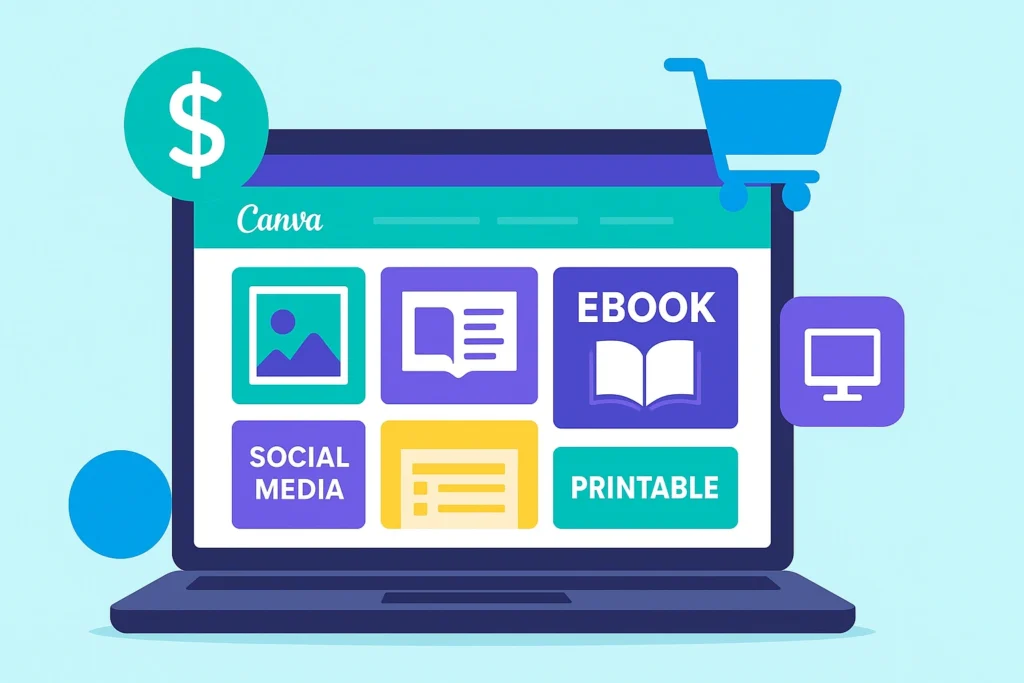Make Money With Canva: 15 Smart Ways to Turn Your Designs Into Income$$

Do you ever feel like your creativity is under-utilized? Maybe you’ve spent hours playing around with Canva templates, designing graphics for fun, but wondered if you could make real money doing just that. You’re not alone. Many people see Canva as a hobby tool — but miss out on its huge potential to generate side income or even a full hustle.
What if you could take those simple designs, those ideas you sketch in your free time, and transform them into dollars in your bank account? Canva offers low barriers to entry, minimal startup cost, and tons of ways to monetize your creativity — you just need the right plan. In this post, you’ll discover exactly how to do that: real methods people are using today, step-by-step strategies that work, and clever tips you won’t hear everywhere else.
By the end of this guide, you’ll see how you can make money with Canva by selling templates, do freelance design work, leverage print-on-demand, and more — even if you’re a beginner. No fluff, no overpromising — just actionable ideas so you can start making money with Canva now.
RELATED POSTS:
8 Proven Ways to Make Money Without a Job
How to Make Money Selling on Facebook Marketplace
How much does a Canva Creator make?
If you’re thinking about diving into Canva to earn money, the first big question is always the same: what’s the earning potential? It’s natural to wonder whether becoming a Canva Creator can actually turn into a reliable income stream or if it’s just spare change. Let’s clear that up with real numbers and examples.
On the lower end, many new creators earn just $1 to $50 per month in the beginning. This usually happens when their portfolios are small or they’re still figuring out what designs people actually want. But here’s the good news — those who keep adding trendy, in-demand templates quickly see results scale up.
For instance, creators who consistently upload dozens or even hundreds of high-quality templates often reach $500 to $3,000 per month. Some who specialize in social media templates, planners, or business kits even report hitting $2,000–$5,000 monthly once their designs start trending. According to Canva’s own Contributor Guidelines and user reports shared on forums like Reddit’s side hustle discussions, it’s clear that this growth is very achievable for those willing to put in consistent effort.
So, while Canva won’t make you rich overnight, the opportunity is clear: start small, learn what sells, and build your portfolio steadily. The more you grow, the more you can realistically expect earnings that move from side hustle money to something far more significant.
👉 Ready to give it a shot? Sign up for Canva here to kickstart your journey and start creating templates that can earn for you even while you sleep.
15 Profitable Ways to Earn Money on Canva
Now that you know the scope of earning as a Canva Creator, let’s get into the exciting part—how you can actually make money using Canva. Whether you’re a stay-at-home parent, a freelancer, or just someone looking for an extra income stream, Canva offers plenty of opportunities. From selling ready-made templates to offering design services, these ideas are simple to start and can scale as your skills grow.
1. Create and Sell Canva Templates
One of the easiest and most profitable ways to make money with Canva is by selling ready-made templates. Think about it: people are always looking for beautifully designed resumes, planners, social media posts, business cards, and presentations. Many don’t have the time (or design skills) to create them from scratch—that’s where you step in.
Here’s how to get started:
- Pick a niche – Choose something in demand like Instagram posts, resumes, or wedding invitations. (Check marketplaces like Etsy to see what’s trending.)
- Design in Canva – Create templates that are editable so buyers can easily customize them.
- Sell on platforms – List your templates on Etsy, Creative Market, or even your own website.
- Promote smartly – Use Pinterest or TikTok to showcase your designs—it’s free traffic and converts well.
The best part? You create once and sell the same template over and over, building a passive income stream.
2. Design and Sell Printables
Printables are a booming digital product market—from planners and calendars to budgeting sheets, wall art, and kids’ activity pages. People love them because they can instantly download, print, and use them at home. And the best part? You only create once, then sell endlessly without worrying about shipping or stock.
Here’s your step-by-step guide:
- Research what’s trending – Head over to Etsy and search “printables.” You’ll see what shoppers are actively buying (think meal planners, budget trackers, or habit trackers).
- Create in Canva – Use Canva’s pre-built elements, fonts, and layouts to design professional-looking printables. Keep them simple, clean, and easy for anyone to use.
- Sell on marketplaces – Etsy, Gumroad, or your own Shopify store are great places to list your products.
- Automate delivery – Upload your designs as instant downloads so buyers get them right away (zero manual work for you).
With just a few solid designs, you can build a shop that earns sales 24/7. Think of it as creating a mini digital asset library that pays you over and over again.
3. Become a Canva Contributor
If you love creating graphics, illustrations, or photos, you can actually earn money directly from Canva by becoming a Canva Contributor. As a contributor, you upload your designs—whether it’s templates, stock photos, icons, or elements—and each time someone uses your work in Canva, you get paid a royalty.
How it works:
- Apply as a Contributor – Canva has an application process where you submit a portfolio of your designs. Once approved, you’ll get access to upload your work.
- Upload high-demand content – Templates for social media, resumes, presentations, and simple graphics perform really well. Stock photos, backgrounds, and elements are also in high demand.
- Earn passive income – Each time your design is used by Canva’s massive user base (over 150 million monthly active users), you get a royalty.
💡 Example: Some top Canva contributors report earning $200 to $1,000+ per month just from their uploaded designs. While results vary, your income can grow steadily the more content you publish. This is one of the most hands-off ways to monetize Canva—because once your designs are up, they can keep generating royalties for years without extra effort.
4. Start a Print-on-Demand Business
One of the most exciting ways to make money with Canva is by starting a print-on-demand (POD) business. Imagine designing a t-shirt, mug, tote bag, or notebook once—and then selling it over and over without worrying about inventory or shipping. That’s exactly what POD offers.
Here’s how it works:
- Design your products in Canva – Create eye-catching designs for t-shirts, hoodies, mugs, phone cases, or even stickers. Canva’s drag-and-drop editor makes it super easy to create professional-looking designs, even if you’re not a designer.
- Partner with a POD platform – Sites like Printful, Printify, and Redbubble let you upload your Canva designs and sell them directly through their marketplace or integrate with your own Shopify/Etsy store.
- Sell without inventory risk – When someone places an order, the POD company prints, packs, and ships it to the customer under your brand. You don’t have to buy stock upfront.
- Market your products – Use Instagram, Pinterest, or TikTok to showcase lifestyle shots of your designs. Pair this with an Etsy shop or Shopify store to maximize reach.
💡 Real example: Many small businesses on Etsy make $500 to $5,000+ per month with simple Canva-designed t-shirts and mugs. Since POD is scalable, the more trending designs you create, the more sales you can generate.
This side hustle is a great fit for stay-at-home moms, students, or anyone who wants to build a flexible business with low startup costs.
👉 If you’re serious about it, start experimenting today with Canva designs and connect them to a POD platform to kickstart your online shop.
5. Design Logos for Small Businesses
Every new business—whether it’s a bakery, a boutique, or an online shop—needs a logo that makes them stand out. But here’s the thing: not every small business owner has the budget to hire a professional designer. That’s where you and Canva come in.
With Canva’s logo templates and easy drag-and-drop tools, you can create professional, unique logos in minutes—even if you’re not a design expert. Many entrepreneurs are looking for affordable branding options, and they’re more than happy to pay $50–$200 for a simple but polished logo.
Here’s how you can get started:
- Build a small portfolio – Use Canva to design sample logos for mock businesses (like a coffee shop, clothing line, or fitness studio). This shows potential clients what you can do.
- Start offering services – Platforms like Fiverr, Upwork, or even Etsy are great places to list your logo design services. You can also pitch directly to small businesses in your local area.
- Add extra value – Instead of just a logo, package it with a brand kit (color palette, font pairing, social media banner). This small upsell can double your income per client.
- Market yourself on social media – Share before-and-after logo transformations or quick Canva design tips. This builds trust and attracts paying clients.
💡 Example: Many Canva designers on Fiverr earn $500 to $2,000 per month just from creating logos and simple branding kits. With Canva Pro’s features, you can customize templates and deliver polished, high-quality work clients love.
👉 If you’re ready to try, set up your profile on a freelancing platform, showcase your Canva-made logos, and start pitching small businesses today.
6. Promote Canva as an Affiliate
Here’s a side hustle that doesn’t require you to design anything at all: becoming a Canva affiliate. If you already love Canva and use it often, why not share it with others and earn a commission every time someone signs up?
Canva’s affiliate program lets you earn up to $36 for each new Pro subscriber you refer. Think about how many bloggers, small business owners, teachers, and content creators need a simple design tool—your potential audience is huge.
Here’s how you can start promoting Canva as an affiliate:
- Apply for Canva’s affiliate program through their official site. Once approved, you’ll get your own referral link.
- Choose where to share your link – this could be in a blog post, YouTube video, Pinterest pin, or even a social media tutorial. For example, you might create a guide like “How to Make Social Media Graphics in Canva” and include your affiliate link.
- Provide real value first – instead of just dropping a link, explain why someone should use Canva. Share your own designs, success stories, or time-saving hacks.
- Stay consistent – the more content you create around Canva, the more opportunities for people to click and sign up.
💡 Example: Bloggers in niches like productivity, social media marketing, and small business report earning hundreds to even thousands per month just by recommending Canva to their audience.
👉 If you’re ready to turn your Canva passion into passive income, sign up for Canva Pro here and start promoting it today.
7. Create eBooks for Amazon Kindle
Ever thought about publishing your own eBook? With Canva, you don’t need fancy design software or a degree in graphic design to make it happen. Canva’s ready-made templates make it super easy to create professional-looking eBooks that you can sell directly on Amazon Kindle Direct Publishing (KDP)
Here’s how to do it:
- Pick a profitable topic – Think “how-to guides,” recipe books, self-improvement, or niche hobbies. The best eBooks solve a problem or entertain readers.
- Write your content – Keep it clear, organized, and easy to read. If you’re not comfortable writing long chapters, short guides (30–50 pages) often sell well on Kindle.
- Design in Canva – Use Canva’s eBook templates to create a clean layout, add visuals, and design a catchy cover. A good cover can make all the difference in grabbing attention.
- Format and upload to KDP – Export your file in PDF format and upload it to Amazon Kindle Direct Publishing. Amazon handles distribution and pays you royalties.
💡 Why it works: Many independent authors are making anywhere from a few hundred dollars to several thousand each month by publishing eBooks on Amazon. With Canva, you eliminate the steep design costs that usually come with publishing.
8. Start an Online Canva Course
If you’re already comfortable using Canva and love showing others how to create designs, why not turn that knowledge into a source of income? Online learning is booming, and Canva is a skill that tons of entrepreneurs, small business owners, and freelancers want to master. This is where you can step in by creating a Canva course.
Here’s how to get started:
- Pick your niche – Don’t just teach “Canva basics.” Instead, focus on a profitable angle: “Canva for Social Media Marketing,” “Designing eBooks in Canva,” or “Canva for Small Businesses.” Specific courses sell better because they solve targeted problems.
- Outline your lessons – Break your course into bite-sized modules. For example: Introduction, Branding Basics, Social Media Graphics, Advanced Hacks, and Monetization Tips.
- Record your content – You don’t need expensive gear. A simple screen recorder and clear audio is enough. Walk students through your Canva dashboard, showing them step by step how to create real designs.
- Choose a platform – You can sell on Udemy, Skillshare, or even host it yourself on Teachable or Thinkific. Udemy and Skillshare give you instant traffic, while hosting it yourself gives you more control (and higher profits).
- Market your course – Share free Canva tips on Instagram, TikTok, or Pinterest, and funnel that audience into your course. You could also bundle freebies (like a few Canva templates) as a lead magnet.
💡 Earning potential: Successful Canva instructors on Udemy and Skillshare often make $1,000–$10,000/month, depending on course quality and marketing. Even a small, self-hosted course priced at $49 can generate steady side income if you consistently promote it.
👉 Pro tip: If you’re just starting out, you can even record your first course using Canva’s presentation + screen record feature — it’s simple and looks professional
9 Create Social Media Posts For Businesses
Every business today needs a strong social media presence, but not every owner has the time or creativity to design eye-catching posts. That’s where you come in. With Canva, you can design scroll-stopping social media content and offer it as a service to small businesses, startups, and even busy influencers.
Here’s how you can get started:
- Pick a platform focus – Some businesses care most about Instagram, while others are active on LinkedIn, Facebook, or TikTok. Choose one or two platforms to specialize in so you can tailor your designs.
- Create content packages – Instead of charging per post, offer bundles like “10 Instagram posts + 5 Stories” or “30 ready-to-go Facebook graphics.” This makes your offer more attractive and scalable.
- Use Canva’s templates as a base – Start with pre-made templates, then customize colors, fonts, and layouts to match the client’s branding. This saves time while keeping everything professional.
- Showcase your work – Build a small portfolio on Instagram, Pinterest, or even a Google Drive folder. Potential clients want to see what you can create.
- Find clients – Reach out to local businesses, browse freelance platforms like Fiverr or Upwork, or network in Facebook business groups. Many entrepreneurs are willing to pay $200–$500/month for ongoing content support.
💡 Example: A coffee shop might pay you to design a month’s worth of posts highlighting their daily specials, events, and customer reviews. With Canva, you could batch-create these designs in a couple of hours.
👉 Pro tip: Offer an upsell by including caption writing + hashtags along with the visuals. Businesses love “done-for-you” services that save them time.
10. Make Ads & Create Marketing Videos
If there’s one thing businesses are willing to spend on, it’s ads that actually convert. But hiring a professional video editor or agency can be expensive, so many small businesses turn to freelancers who can deliver polished ads and marketing videos at a fraction of the cost. With Canva’s drag-and-drop video editor, you don’t need to be a pro filmmaker to create eye-catching ad content.
Here’s how you can start making money with ads and videos in Canva:
- Understand the goal of the ad – Before designing, ask the client what they want: more sales, more clicks, or brand awareness. This helps you create a video that feels aligned with their target.
- Use Canva’s pre-built templates – Canva has ready-made ad templates for Instagram, Facebook, TikTok, and YouTube. You can customize colors, fonts, and animations so each video looks unique to the brand.
- Incorporate storytelling – A successful ad isn’t just visuals; it tells a mini story. Use Canva’s text animations, stock footage, and music library to hook attention in the first 3 seconds.
- Test different versions – Businesses love when freelancers provide multiple ad variations. Create 2–3 short clips with slightly different headlines or designs so they can A/B test which works best.
- Charge for value, not just time – Don’t undervalue yourself. Businesses can make thousands from a well-performing ad, so charging $100–$300 per video is reasonable even if Canva makes the process quick.
💡 Example: A boutique clothing brand might pay you to create a 15-second Instagram Reel showcasing their summer collection. With Canva, you can combine product photos, animated text, and upbeat visuals to produce a professional-looking ad in under an hour.
👉 Pro tip: Offer video ad packages (like “3 Instagram Reels + 2 TikTok Ads”) to increase your earnings and give clients more content to work with.
And here’s the best part — you don’t need expensive software like Adobe Premiere or Final Cut Pro. Canva’s built-in editor lets you export high-quality MP4 videos that are ready to upload directly to ad platforms.
11. Become a Canva YouTuber
YouTube is one of the best platforms to share your skills and earn passive income, and Canva is the perfect niche to start with. Thousands of people are searching daily for tutorials like “How to make a resume in Canva,” “How to design Instagram posts,” or “Best Canva tips for beginners.” That means there’s a massive audience waiting for your content.
The beauty? You don’t need fancy editing software or even a professional camera. You can use Canva itself to create video intros, screen-record your tutorials, and edit clips.
Here’s how you can turn Canva into a YouTube channel income stream:
- Pick your niche focus – Maybe you’ll target small business owners who want Canva ads, students who need resumes, or bloggers who want Pinterest graphics. Having a niche helps you stand out.
- Create tutorial-style content – People love step-by-step guides. For example, “How to Design an eBook Cover in Canva (No Experience Needed)” could attract thousands of views.
- Monetize with YouTube ads – Once you hit 1,000 subscribers and 4,000 watch hours, you can join the YouTube Partner Program and start earning from ads.
- Use affiliate marketing – This is where it gets powerful. In your video descriptions, you can share your Canva affiliate link so viewers can sign up directly. If they upgrade to Canva Pro, you earn a commission.
- Expand income streams – Besides ads and affiliate commissions, you can sell your own Canva templates, eBooks, or even online courses through your channel.
💡 Example: There are creators like “Design with Canva” channels who generate thousands of dollars monthly just by posting consistent tutorials. Some make even more by combining YouTube ad revenue + affiliate commissions + digital product sales.
👉 CTA tip: At the end of your videos, always remind viewers to check the link in your description — this is where you can promote Canva Pro and other design resources.
And the best part? Unlike freelancing, YouTube income scales with time. A video you make today can keep getting views (and generating money) for months or even years ahead.
12. Design Websites
Not everyone knows this, but Canva has a website design feature that allows you to create simple, one-page websites without needing coding or complicated tools. This opens up a huge opportunity because so many small business owners, freelancers, and even students want a professional-looking website but can’t afford expensive designers.
Here’s the good news: you don’t need to be a web developer to start. Canva offers customizable templates for portfolios, landing pages, event pages, and business sites. With drag-and-drop tools, you can design a site in hours — then either publish it directly through Canva or export it for hosting elsewhere.
Steps to turn this into income:
- Offer affordable web design services – Target small businesses, bloggers, or local shops that want an online presence but have a tight budget.
- Create niche-specific website templates – For example, restaurant menus, personal portfolios, or real estate landing pages. You can sell these templates on platforms like Etsy or your own store.
- Bundle your service – Instead of just delivering a website, you can offer extras like social media graphics, a brand kit, or logo design (all created with Canva). This increases your earnings per project.
- Promote through freelancing platforms – Sites like Fiverr and Upwork already have buyers searching for “affordable website design.” With Canva, you can deliver fast, beautiful results.
💡 Example: Some freelancers are already charging $100–$500 per Canva-designed website depending on customization. If you position yourself as a budget-friendly but reliable option, you can land multiple clients per month.
👉 Pro tip: Add your Canva affiliate link in your portfolio or proposals. If a client upgrades to Canva Pro for easier customization, you’ll earn commission on top of your service fee.
The best part? Unlike coding-heavy web design, Canva websites are easy to maintain, so clients will love how simple it is to update — and you’ll keep getting repeat work.
13. Start a Canva Consulting or Coaching Business
Here’s something most people overlook: while Canva is beginner-friendly, not everyone knows how to use it effectively. Business owners often waste hours trying to design graphics, teachers struggle with creating lesson plans, and even content creators get stuck figuring out branding. That’s where you can step in as a Canva consultant or coach.
Instead of just designing for clients, you teach them how to leverage Canva for their specific needs. This can include:
- Helping small businesses create branded templates for social media.
- Coaching content creators on how to design eye-catching YouTube thumbnails or Instagram posts.
- Training virtual assistants or freelancers who want to add Canva as a skill.
How to start:
- Pick a niche – For example, “Canva for small business marketing” or “Canva for teachers.” Having a focus makes you stand out.
- Offer one-on-one coaching sessions – You can use Zoom or Google Meet to walk clients through Canva in real-time.
- Create packages – Sell a “90-minute Canva crash course” or “3-session branding with Canva” program.
- Promote your expertise – Share tips on LinkedIn, TikTok, or even YouTube. This builds authority and attracts paying clients.
💡 Real example: Canva experts on platforms like Clarity.fm or Fiverr charge anywhere from $30 to $150 per hour for consulting. Some even scale it into full online courses, making thousands each month.
The beauty of Canva consulting is that you’re not just making money once. You’re building a personal brand as a go-to Canva expert, which means repeat clients, referrals, and even opportunities to collaborate with bigger businesses.
14. Offer Custom Resume & Cover Letter Design Services
Let’s be real — sending out a plain, text-only resume doesn’t cut it anymore. Recruiters see hundreds of applications daily, and a resume that looks polished and professional instantly grabs attention. The same goes for cover letters — design matters almost as much as content. That’s where you can use Canva to create custom resumes and cover letters that stand out.
Here’s how to get started:
- Pick a style – Canva has modern, creative, and professional templates you can tweak for different industries. For example, a resume for a tech job might be sleek and minimal, while a design role could use more creative flair.
- Offer personalization – Go beyond filling in details. Customize fonts, colors, and layouts so each resume matches the client’s personal brand.
- Bundle services – Sell a package that includes a resume + matching cover letter design, or even add a LinkedIn banner for extra value.
- List your services online – Platforms like Fiverr, Upwork, and Etsy are great places to showcase your designs. You can also pitch directly to college graduates, job seekers, or professionals on LinkedIn.
💡 Real example: On Etsy, resume templates sell for anywhere between $10 to $40 each — and many sellers rack up hundreds of monthly sales. If you offer fully custom resumes, you can charge $100+ per client depending on the level of service.
👉 Pro tip: Sign up for Canva Pro to unlock premium fonts, layouts, and brand kits — it makes your resume services more professional and flexible.
This side hustle works because people are always job hunting. As long as careers exist, resume and cover letter design will stay in demand, giving you a steady income stream with Canva.
15. Design Email Graphics for Bloggers or Newsletters
Think about the last email you opened. Did you keep reading because of the walls of text — or because of the visuals that made it pop? Exactly. Strong visuals are what keep readers hooked, and that’s why bloggers, small businesses, and even big brands are always looking for eye-catching email graphics.
With Canva, you can design headers, banners, buttons, and promotional images that make newsletters look professional and on-brand. Many bloggers aren’t designers, so they’re happy to outsource this part to someone skilled. Here’s how you can get started:
- Identify your niche – Food bloggers might need recipe headers, travel bloggers could want destination-themed graphics, and e-commerce stores often need promo banners.
- Create ready-to-use templates – Instead of starting from scratch every time, design reusable email graphics that clients can plug their text into.
- Offer bundles – Sell a monthly package that includes 4–6 graphics tailored to their newsletter. This gives you recurring income while making their emails look consistent.
- Promote your services – List them on freelance sites like Fiverr or Upwork, or reach out directly to bloggers and newsletter creators.
💡 Example: Many freelancers charge $50–$200 per email design package, especially when bundling graphics for multiple newsletters. If you land even 5 recurring clients, that’s a few hundred extra dollars every month.
👉 Pro tip: Canva Pro makes this easier by allowing you to save brand kits (fonts, logos, colors). That way, you can quickly design graphics that match each client’s brand without extra work.
At the end of the day, every blogger and business owner wants emails that stand out in a crowded inbox. If you can deliver designs that do just that, you’ve got yourself a profitable Canva side hustle.
Conclusion: Ready to Start Making Money with Canva?
By now, you’ve seen just how versatile Canva can be — from selling templates and printables to creating courses, running a print-on-demand shop, or even consulting. The beauty of Canva is that you don’t need to be a professional designer or invest in expensive software. With just creativity, consistency, and a willingness to learn, you can turn this simple tool into a reliable stream of income.
Whether you’re looking for a side hustle to make extra cash or dreaming of building a full-time business, Canva gives you the platform and resources to do it. The opportunities are endless, and people everywhere are willing to pay for designs that save them time and make their brand shine.
👉 Ready to kickstart your journey? Sign up for Canva Pro here and get access to premium tools, templates, and features that can help you grow faster and stand out from the competition. Your next side hustle could be just one design away. 🚀






